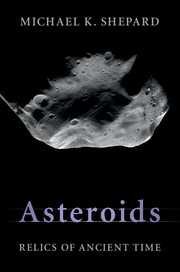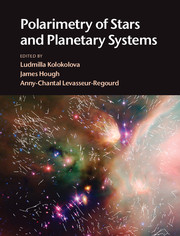Refine listing
Actions for selected content:
17000 results
14 - Stellar magnetic fields
- from III - Stars and their environment
-
-
- Book:
- Polarimetry of Stars and Planetary Systems
- Published online:
- 05 May 2015
- Print publication:
- 14 May 2015, pp 224-243
-
- Chapter
- Export citation
3 - Measurement and modeling of electromagnetic scattering by particles and particle groups
- from II - Theory, instrumentation, and laboratory studies
-
-
- Book:
- Polarimetry of Stars and Planetary Systems
- Published online:
- 05 May 2015
- Print publication:
- 14 May 2015, pp 13-34
-
- Chapter
- Export citation
11 - T Tauri and Herbig Ae/Be stars
- from III - Stars and their environment
-
-
- Book:
- Polarimetry of Stars and Planetary Systems
- Published online:
- 05 May 2015
- Print publication:
- 14 May 2015, pp 176-198
-
- Chapter
- Export citation
Index
-
- Book:
- Polarimetry of Stars and Planetary Systems
- Published online:
- 05 May 2015
- Print publication:
- 14 May 2015, pp 482-487
-
- Chapter
- Export citation
I - Introduction
-
- Book:
- Polarimetry of Stars and Planetary Systems
- Published online:
- 05 May 2015
- Print publication:
- 14 May 2015, pp 1-10
-
- Chapter
- Export citation
17 - Terrestrial planets
- from IV - Solar system
-
-
- Book:
- Polarimetry of Stars and Planetary Systems
- Published online:
- 05 May 2015
- Print publication:
- 14 May 2015, pp 289-302
-
- Chapter
- Export citation
26 - Astrobiology
- from V - Exoplanets and exobiology
-
-
- Book:
- Polarimetry of Stars and Planetary Systems
- Published online:
- 05 May 2015
- Print publication:
- 14 May 2015, pp 462-478
-
- Chapter
- Export citation
IV - Solar system
-
- Book:
- Polarimetry of Stars and Planetary Systems
- Published online:
- 05 May 2015
- Print publication:
- 14 May 2015, pp 265-436
-
- Chapter
- Export citation
III - Stars and their environment
-
- Book:
- Polarimetry of Stars and Planetary Systems
- Published online:
- 05 May 2015
- Print publication:
- 14 May 2015, pp 145-264
-
- Chapter
- Export citation
9 - Interstellar polarization
- from III - Stars and their environment
-
-
- Book:
- Polarimetry of Stars and Planetary Systems
- Published online:
- 05 May 2015
- Print publication:
- 14 May 2015, pp 147-161
-
- Chapter
- Export citation
Dedication
-
- Book:
- Polarimetry of Stars and Planetary Systems
- Published online:
- 05 May 2015
- Print publication:
- 14 May 2015, pp v-vi
-
- Chapter
- Export citation
8 - Experimental scattering matrices of clouds of randomly oriented particles
- from II - Theory, instrumentation, and laboratory studies
-
-
- Book:
- Polarimetry of Stars and Planetary Systems
- Published online:
- 05 May 2015
- Print publication:
- 14 May 2015, pp 130-144
-
- Chapter
- Export citation

Asteroids
- Relics of Ancient Time
-
- Published online:
- 05 May 2015
- Print publication:
- 16 April 2015

Precession, Nutation and Wobble of the Earth
-
- Published online:
- 05 May 2015
- Print publication:
- 16 April 2015

Inflation and String Theory
-
- Published online:
- 05 May 2015
- Print publication:
- 23 April 2015

Polarimetry of Stars and Planetary Systems
-
- Published online:
- 05 May 2015
- Print publication:
- 14 May 2015
6 - Conclusions and outlook
-
- Book:
- Inflation and String Theory
- Published online:
- 05 May 2015
- Print publication:
- 23 April 2015, pp 262-264
-
- Chapter
- Export citation
Dedication
-
- Book:
- Inflation and String Theory
- Published online:
- 05 May 2015
- Print publication:
- 23 April 2015, pp vii-viii
-
- Chapter
- Export citation
Notation and conventions
-
- Book:
- Inflation and String Theory
- Published online:
- 05 May 2015
- Print publication:
- 23 April 2015, pp xxi-xxii
-
- Chapter
- Export citation
Index
-
- Book:
- Inflation and String Theory
- Published online:
- 05 May 2015
- Print publication:
- 23 April 2015, pp 367-371
-
- Chapter
- Export citation
